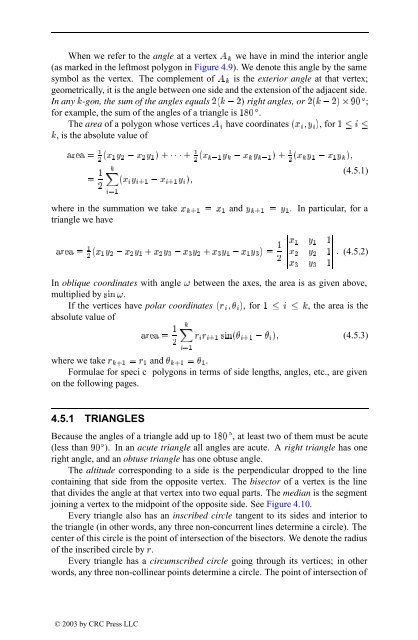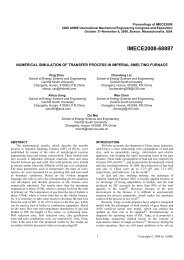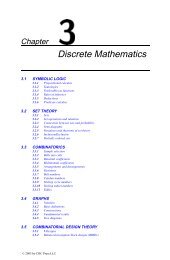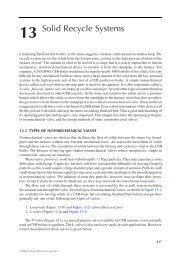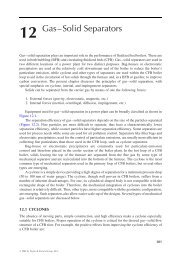Chapter 4: Geometry
Chapter 4: Geometry
Chapter 4: Geometry
You also want an ePaper? Increase the reach of your titles
YUMPU automatically turns print PDFs into web optimized ePapers that Google loves.
When we refer to the angle at a vertex we have in mind the interior angle<br />
(as marked in the leftmost polygon in Figure 4.9). We denote this angle by the same<br />
symbol as the vertex. The complement of is the exterior angle at that vertex;<br />
geometrically, it is the angle between one side and the extension of the adjacent side.<br />
In any -gon, the sum of the angles equals ¾´ ¾µ right angles, or ¾´ ¾µ ¢ ¼ Æ ;<br />
for example, the sum of the angles of a triangle is ½¼ Æ .<br />
The area of a polygon whose vertices have coordinates ´Ü Ý µ, for ½ <br />
, is the absolute value of<br />
Ö ½ ´Ü ¾ ½Ý ¾ Ü ¾ Ý ½ µ·¡¡¡· ½ ´Ü ¾ ½Ý Ü Ý ½ µ· ½ ´Ü ¾ Ý ½ Ü ½ Ý µ<br />
<br />
½ (4.5.1)<br />
´Ü Ý ·½ Ü ·½ Ý µ<br />
¾<br />
½<br />
where in the summation we take Ü ·½ Ü ½ and Ý ·½ Ý ½ . In particular, for a<br />
triangle we have<br />
Ö ½ ¾ ´Ü ½Ý ¾ Ü ¾ Ý ½ · Ü ¾ Ý ¿ Ü ¿ Ý ¾ · Ü ¿ Ý ½ Ü ½ Ý ¿ µ ½ ¾<br />
¬<br />
¬<br />
Ü ½ Ý ½ ½<br />
Ü ¾ Ý ¾ ½<br />
Ü ¿ Ý ¿ ½¬ (4.5.2)<br />
In oblique coordinates with angle between the axes, the area is as given above,<br />
multiplied by ×Ò .<br />
If the vertices have polar coordinates ´Ö µ, for ½ , the area is the<br />
absolute value of<br />
Ö ½ ¾<br />
<br />
½<br />
Ö Ö ·½ ×Ò´ ·½ µ (4.5.3)<br />
where we take Ö ·½ Ö ½ and ·½ ½ .<br />
Formulae for speci c polygons in terms of side lengths, angles, etc., are given<br />
on the following pages.<br />
4.5.1 TRIANGLES<br />
Because the angles of a triangle add up to ½¼ Æ , at least two of them must be acute<br />
(less than ¼ Æ ). In an acute triangle all angles are acute. A right triangle has one<br />
right angle, and an obtuse triangle has one obtuse angle.<br />
The altitude corresponding to a side is the perpendicular dropped to the line<br />
containing that side from the opposite vertex. The bisector of a vertex is the line<br />
that divides the angle at that vertex into two equal parts. The median is the segment<br />
joining a vertex to the midpoint of the opposite side. See Figure 4.10.<br />
Every triangle also has an inscribed circle tangent to its sides and interior to<br />
the triangle (in other words, any three non-concurrent lines determine a circle). The<br />
center of this circle is the point of intersection of the bisectors. We denote the radius<br />
of the inscribed circle by Ö.<br />
Every triangle has a circumscribed circle going through its vertices; in other<br />
words, any three non-collinear points determine a circle. The point of intersection of<br />
© 2003 by CRC Press LLC


